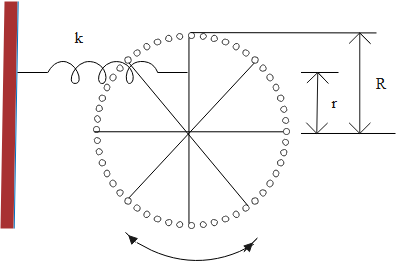
A wheel is free to rotate about its fixed axle. A spring is attached to one of its spokes a distance r from the axle, as shown in the above figure. (a) Assuming that the wheel is a hoop of mass m and radius R, what is the angular frequency v of small oscillations of this system in terms of m, R, r and the spring constant k? What is


Answer
450.6k+ views
1 likes
Hint: Rotational energy and spring energy are forms of kinetic energy. The rotational energy is related to the wheel, whereas, the spring energy is related to the spring. We will find the expressions for the spring energy and the rotational kinetic emery. Then, we will equate both of the expressions to find the expression for the angular frequency.
Formula used:
Complete step-by-step answer:
From the given information, we have the data as follows.
The radius of the wheel is,
The distance between the centre of the wheel and the spring is,
The spring constant is,
The angular frequency is,
The mass of the wheel is,
In the case of the wheel, the rotational inertia is,
Where
In the case of the wheel, the rotational kinetic energy is computed as follows.
Where
Now substitute the expressions of the rotational inertia and the angular frequency in the above equation.
Here,
The spring energy is given as follows.
Where
The energy will remain constant when the rotational kinetic energy equals the spring energy. So, we have,
Substitute the expressions of the rotational kinetic energy and the spring energy in the above equation.
Represent the above expression in terms of the angular frequency.
Therefore, the expression for the angular frequency is,
(a) The angular frequency v of small oscillations of this system in terms of m, R, r and the spring constant k is,
When the radius of the wheel is equals the distance between the centre of the wheel and the spring, then, the angular frequency is,
(b) The angular frequency
When the distance between the centre of the wheel and the spring equals zero, then, the angular frequency is,
(c) The angular frequency(
Note: The representation of the rotational energy of the wheel and the spring energy of the spring in terms of kinetic energy should be known. The equations of the rotational kinetic energy and the rotational kinetic energy can be equated if both, the wheel and the spring are told to be in motion.
Formula used:
Complete step-by-step answer:
From the given information, we have the data as follows.
The radius of the wheel is,
The distance between the centre of the wheel and the spring is,
The spring constant is,
The angular frequency is,
The mass of the wheel is,
In the case of the wheel, the rotational inertia is,
Where
In the case of the wheel, the rotational kinetic energy is computed as follows.
Where
Now substitute the expressions of the rotational inertia and the angular frequency in the above equation.
Here,
The spring energy is given as follows.
Where
The energy will remain constant when the rotational kinetic energy equals the spring energy. So, we have,
Substitute the expressions of the rotational kinetic energy and the spring energy in the above equation.
Represent the above expression in terms of the angular frequency.
Therefore, the expression for the angular frequency is,
(a) The angular frequency v of small oscillations of this system in terms of m, R, r and the spring constant k is,
When the radius of the wheel is equals the distance between the centre of the wheel and the spring, then, the angular frequency is,
(b) The angular frequency
When the distance between the centre of the wheel and the spring equals zero, then, the angular frequency is,
(c) The angular frequency(
Note: The representation of the rotational energy of the wheel and the spring energy of the spring in terms of kinetic energy should be known. The equations of the rotational kinetic energy and the rotational kinetic energy can be equated if both, the wheel and the spring are told to be in motion.
Latest Vedantu courses for you
Grade 11 Science PCM | CBSE | SCHOOL | English
CBSE (2025-26)
School Full course for CBSE students
₹41,848 per year
Recently Updated Pages
Master Class 9 General Knowledge: Engaging Questions & Answers for Success

Master Class 9 English: Engaging Questions & Answers for Success

Master Class 9 Science: Engaging Questions & Answers for Success

Master Class 9 Social Science: Engaging Questions & Answers for Success

Master Class 9 Maths: Engaging Questions & Answers for Success

Class 9 Question and Answer - Your Ultimate Solutions Guide

Trending doubts
State and prove Bernoullis theorem class 11 physics CBSE

Who built the Grand Trunk Road AChandragupta Maurya class 11 social science CBSE

1 ton equals to A 100 kg B 1000 kg C 10 kg D 10000 class 11 physics CBSE

State the laws of reflection of light

One Metric ton is equal to kg A 10000 B 1000 C 100 class 11 physics CBSE

Difference Between Prokaryotic Cells and Eukaryotic Cells




